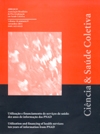0221/2009 - Padrões espaciais da Tuberculose e sua associação à condição de vida no município de Ribeirão Preto
Spatial patterns of Tuberculosis x Adapted Living Condition Index in Ribeirão Preto
Autor:
• Paula Hino - HIno P - Ribeirão Preto, SP - Escola de Enfermagem de Ribeirão Preto- USP/DEMISP - <paulahino@yahoo.com.br>Área Temática:
Não CategorizadoResumo:
Estudo com delineamento híbrido, ecológico e de tendência temporal cujos objetivos foram obter a correlação espacial da ocorrência dos casos novos de Tuberculose, no período 2000 a 2006 e estudar, no ano de 2000, a associação entre a condição de vida e a distribuição da Tb, para o Município de Ribeirão Preto - São Paulo. Os mapas temáticos foram realizados com auxílio do software MapInfo 7.5 e a análise estatística espacial, por meio do Spring 4.3. Para os demais cálculos, utilizou-se o SPSS 10.0. Os indicadores que apresentaram as maiores cargas fatoriais foram chefes de família com renda menor ou igual a 2 salários mínimos e menos de 3 anos de estudo. A comparação dos mapas de condição de vida e Tuberculose evidenciou relação entre a doença e áreas mais carentes do Município, visto que o coeficiente de incidência no cluster de baixa condição de vida foi de 49,9/100.000 habitantes. A Razão de Chances bruto para o cluster de baixa condição de vida foi igual a 3,30 (RC= 3,30; IC 95%: 1,90-5,70). A estratificação do Município segundo condições de vida e ocorrência da doença no Município permitiu a identificação de áreas de risco, fornecendo subsídios para o Programa de Controle da Tuberculose local.Palavras-chave: condições sociais, conglomerados espaço-temporais, epidemiologia, tuberculose
Abstract:
This study, with a hybrid, ecological and time-tendency design, aimed to study the relation between the Adapted Living Condition Index and the spatial distribution in the occurrence of Tb in the year 2000 and to obtain the spatial correlation in case occurrence, in Ribeirão Preto, between 2000 and 2006. The thematic maps were elaborated with the help of MapInfo 7.5 and spatial statistical analysis using Spring 4.3. For further calculations SPSS 10.0 was used. As to the indices that made up the Synthetic Living Conditions Index, the indices with the highest factor load were family heads gaining 2 minimum wages or less and with less than 3 years of education. The comparison of the living condition and Tuberculosis maps evidenced a relation between Tuberculosis and poorer areas in the city, as the incidence rate in the cluster with the low living condition was 49.9/100,000 inhabitants. The gross Chance Ratio, considering the cluster with the high living conditions as a reference, proved the association between Tuberculosis and living condition and 3.30 for the low living condition cluster (CR= 3.30; CI 95%: 1.90-5.70). The city’s layering according to living conditions and occurrence of Tuberculosis allowed for the identification of risk areas, supporting the local Tuberculosis Control Program.Keywords: social conditions, space-time clustering, epidemiology, tuberculosis












